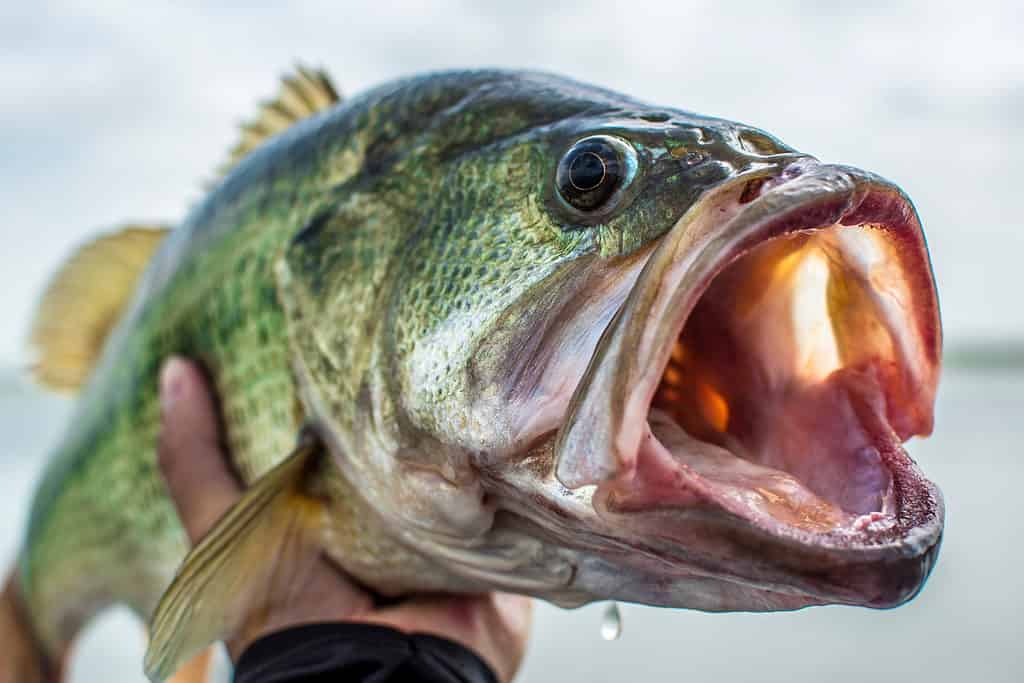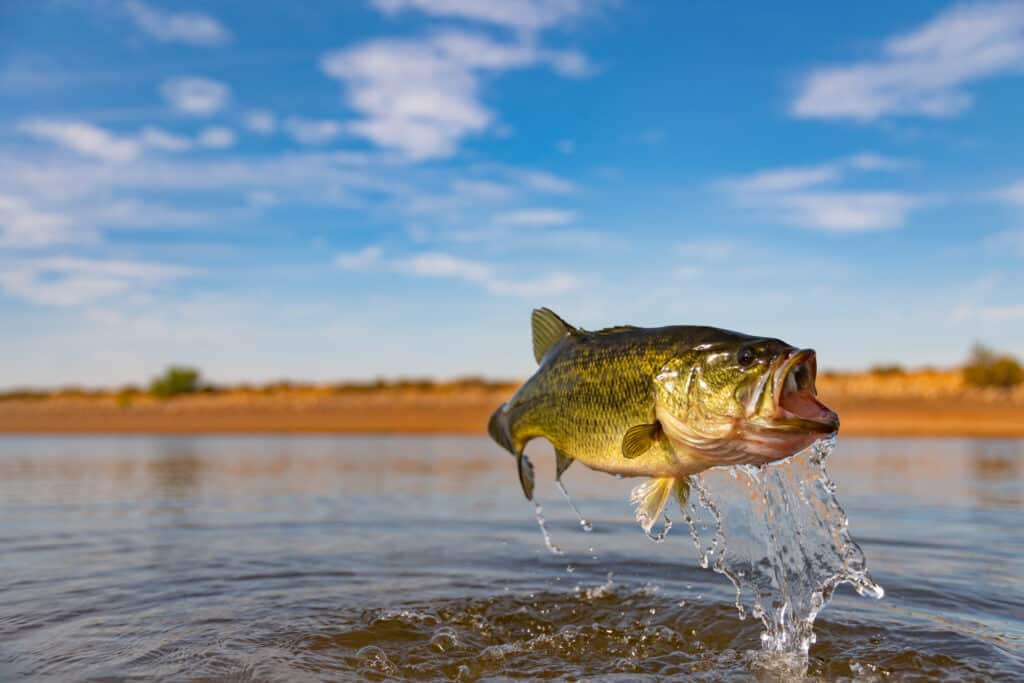Bass fishing is a wildly popular pastime in North America, with its southeastern region having an especially ideal climate for species like the large and smallmouth basses to thrive. Virginia, in particular, boasts many great bass fishing destinations, from the Potomac River to its many reservoirs and lakes. But what is the largest largemouth bass ever caught in Virginia? How does it compare to the largest specimen ever caught worldwide? Keep reading to learn more.

Thanks to its large size, aggressive nature, and physical strength, the largemouth bass tends to be an apex predator.
©Pierre Rebollar/Shutterstock.com
Get to Know the Largemouth Bass
Taxonomically known as Micropterus salmoides, the largemouth bass is one of 13 total species that make up the genus Micropterus. Better known collectively as the black basses, this group of freshwater fish includes species like the spotted, redeye, and smallmouth basses, all of which are native to North America. They mainly prefer slow-moving, warm, clear bodies of freshwater, but they are incredibly hardy and can tolerate a wide range of climates and habitat types.
The largemouth is unique for being not only the largest member of its particular genus but also the largest species within its entire family, Centrarchidae, which is made up of 38 total species. While most black basses range from around 12 to 20 inches long when fully grown, the largemouth bass is capable of reaching close to three feet in length! It’s also a quite hefty fish, with mature adults commonly weighing anywhere from 10 to 15 pounds or more.
Like most other black basses, the largemouth has a predominantly olive green body color with dark brown markings along its sides. Typical of most fish of the order Perciformes, its fins are held up by long, thin, bony rays. It reaches sexual maturity at around one year old and has a lifespan of roughly 10 to 15 years in the wild.
Thanks to its large size, aggressive nature, and physical strength, the largemouth bass tends to be an apex predator. It has few natural predators when fully grown aside from humans. Incredibly, it can eat prey up to half the size of its own body with ease! It mainly feeds on various aquatic invertebrates and small fish, though animals like snakes, amphibians, and even alligator hatchlings can also be on the largemouth’s menu.
Largemouth Bass Fishing: A Brief History

Bass fishing has existed in North America since at least the early 19th century.
©iStock.com/stammphoto
Bass fishing has existed in North America since at least the early 19th century. The first widely-accepted method for largemouth bass fishing was likely fly fishing. Early anglers adapted this from methods used to catch other freshwater fish like trout and salmon.
The largemouth bass began its takeover of the United States’ waterways as early as the mid-1800s! Crucially, this was around the same time as the development of the steam engine and a more refined railway system. During this time, towns cropped up surrounding tank ponds that were stocked with various black bass species.
Black basses were ideal for these tank ponds. They could tolerate a wide range of temperatures and were hardy enough to survive being transported hundreds of miles cross-country. Due to its large size, rather majestic appearance, impressive strength, and “fight” when hooked, the largemouth bass became an increasingly popular trophy fish.
Largemouth Bass Fishing in the last 100 years
As the 1900s rolled around, anglers developed effective methods for catching largemouth bass. Plastic lures became quite popular in the 1950s, as they were often brightly colored, worked well to mimic the largemouth’s prey, and were cheap to produce very quickly. Today, various types of lures are used, from flashy, moving swimbaits to live baits like worms, minnows, and crayfish.
By the latter half of the 1900s, country-wide tournaments emerged surrounding bass fishing, particularly largemouth bass. The B.A.S.S. Federation launched its first tournament in 1967, and the Bassmaster Classic launched in 1971.
Although the largemouth bass is native to North America, it has been introduced to other parts of the world as early as the 1920s. It is now considered invasive in many of these areas, such as Japan, Portugal, Spain, and even parts of South America. Largemouth bass fishing has also become a popular pastime in these regions.
How Big Do Largemouth Bass Get?
The largemouth bass doesn’t just have a large mouth–everything about it is supersized! As the largest species in its entire family, it boasts a maximum size of around three feet long. However, individuals of this size are quite rare, with the average being around 13 to 20 inches or so.
In terms of weight, the largemouth is also an exceptionally bulky fish. By the time they reach sexual maturity at around one year old, most individuals weigh around 5 to 10 pounds. It isn’t terribly uncommon, however, for especially large specimens to hit 15 pounds or more!
It’s also worth noting this species’ prominent sexual dimorphism. This essentially means males and females are visually distinct from one another, mainly when it comes to their sizes. Female largemouth bass are often significantly larger than the males. This is mainly because they can carry thousands of eggs at a time and need larger bodies to accommodate their young.

According to the
Virginia Department of Wildlife Resources
, the largest largemouth bass ever caught in Virginia was 16 pounds and 4 ounces.
©Ryno Botha/Shutterstock.com
What is the Largest Largemouth Bass Ever Caught in Virginia?
According to the Virginia Department of Wildlife Resources, the largest largemouth bass ever caught in Virginia was 16 pounds and 4 ounces. This incredible catch belongs to angler Richard Tate. He caught this record-breaking bass at Lake Conner in Halifax County. There’s even a photo of Tate holding the stunning catch!
Even more impressive, though, is that this record has been held for over 35 years! Tate submitted this record to Virginia’s DWR on May 20th, 1985. Though many have challenged the record since–and some have come very close–none have managed to beat this 16-pound, 4-ounce monster of a bass.
Lake Conner is one of Virginia’s more remote fishing destinations. At around 100 acres, the lake is owned and managed by the aforementioned Virginia DWR. It is home to a surprisingly diverse population of game fish, including largemouth bass, catfish, bluegill, and yellow perch.
Where Is Lake Conner in Halifax County Located on a Map?
Lake Conner is located to the west and south of the Staunton River. It also lies far north of the Dan River. Both rivers are tributaries of the Roanoke River.
What is the Largest Largemouth Bass Ever Caught in the World?

Lake Biwa
is located in Japan’s Shiga Prefecture northeast of Kyoto. It’s also one of Japan’s largest and most well-known fishing destinations!
©beeboys/Shutterstock.com
The largest largemouth bass ever caught in Virginia is definitely impressive, but how does it measure up to the world record? Incredibly, Richard Tate’s record-breaking bass is still about 6 pounds shy of the largest specimen ever caught in the world. But this record isn’t even held by an American angler–it’s actually held by Japanese angler Manabu Kurita of Aichi, Japan.
On July 2nd, 2009, Manabu Kurita caught an astonishing 22-pound, 4.97-ounce largemouth bass at Lake Biwa. Kurita was 31 years old at the time. Lake Biwa is located in Japan’s Shiga Prefecture northeast of Kyoto. It’s also one of Japan’s largest and most well-known fishing destinations! It boasts a diverse population of more than 50 species of game fish, including black basses, catfish, bluegill, and more.
However, although Kurita’s catch is technically the largest, he actually shares the world record with angler George W. Perry of Rentz, Georgia. This is due to an International Game Fish Association regulation that states record-breaking catches must be at least two ounces larger than the previous record. Since Perry and Kurita’s catches are less than an ounce apart, they both hold the world record to this day.
Perry’s record, established all the way back in 1932, weighed 22 pounds, 4 ounces. He caught the whopper of a bass at Georgia’s Montgomery Lake, located in Telfair County. Notably, Perry was just 19 years old at the time. Today, Montgomery Lake remains a small but well-traveled fishing spot, with a historic marker erected to commemorate Perry’s catch.
Up Next:
- Discover the Largest Largemouth Bass Ever Caught
- Smallmouth vs Largemouth Bass: What’s the Difference?
- Discover the Largest Largemouth Bass Ever Caught in Tennessee
The photo featured at the top of this post is © iStock.com/stammphoto
Thank you for reading! Have some feedback for us? Contact the AZ Animals editorial team.






